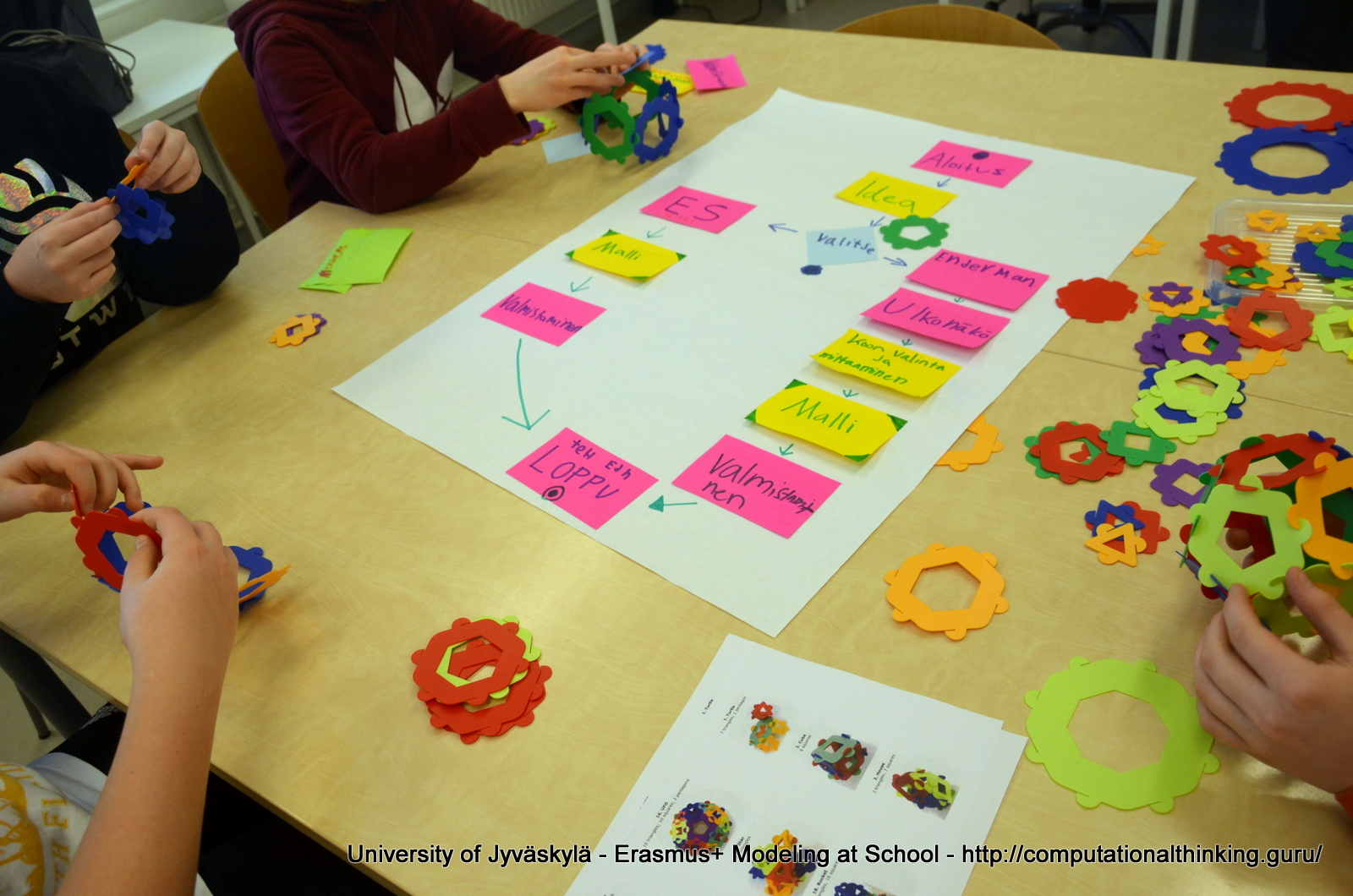Modeling at School / Activities
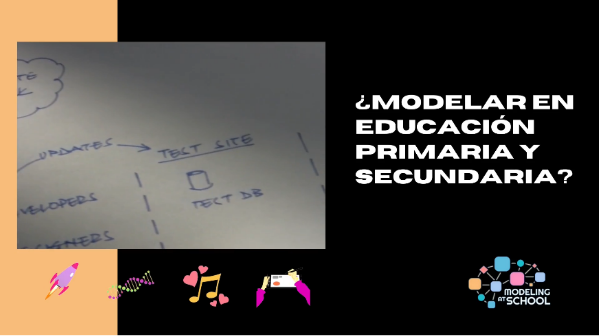
The Life-long Learning Research Group at the Universidad Rey Juan Carlos started an intensive collaboration with schools for the “Modeling at School” Erasmus+ project.
As a first step we created a set of ready-to-use resources in Spanish that mentors could use with their tutors and students at schools. Then we started the promotion of the project, contacting teacher organizations that helped to spread the word among educators. Multipliers and mentors participated in an online webinar and received the educational materials that helped them to be ready for the practical work in schools with their students that they carried out for a couple of months. Finally, we assessed the impact of the project on the modeling skills of participating students.
The resources we elaborated are formed by a set of videos that students could watch in class both independently or in groups, a set of reflection activities about the videos, and a booklet with possible answers to those activities. The videos created (in Spanish) can be seen below.
What is modeling?
Why should I learn to model?
Types of diagrams
E/R diagram
Class and objects diagram
Activity diagram
- Session 1: introduction to modeling
- Sessions 2 and 3: playing with models
- Sessions 4 and 5: creating my own models (Diagram guru challenge)
Visualiza los siguientes vídeos y contesta las preguntas de repaso y reflexión asociadas a cada uno de ellos.
¿Qué es el modelado?
Preguntas de repaso y reflexión
- ¿Cómo definirías, con tus propias palabras, qué es un modelo?
- ¿Cuáles de los siguientes términos crees que es un modelo?
– Un lince ibérico
– Un dibujo de un corazón
– Un autobús de dos plantas
– Una fórmula matemática

3. ¿Qué tipo de modelo sería un esquema que resume un tema, como los que debes tener escritos en tu cuaderno? ¿Mental, gráfico o físico? ¿Y de qué tipo sería una figura de un Museo de Cera?
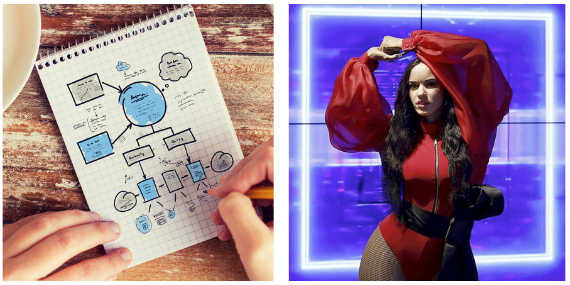
¿Por qué aprender a modelar?
Preguntas de repaso y reflexión
- Pon un ejemplo diferente al del vídeo en el que se muestre en acción la capacidad de abstracción.
- Los patrones son cosas que se repiten de modo predecible. El vídeo muestra patrones en una cerámica y en un copo de nieve. ¿Se te ocurren otros sitios, tanto artísticos como naturales, en los que se puedan reconocer patrones?
- Seguro que en tu día a día ya usas muchos algoritmos (aunque quizás no los llames por este nombre). Por ejemplo, cuando te vas a lavar los dientes siempre sigues los mismos pasos y por el mismo orden, ¿verdad? Describe alguno de estos algoritmos que usas en tu vida diaria.
Tipos de diagramas
Preguntas de repaso y reflexión
- ¿Cómo se llama el lenguaje que define cómo se tienen que crear los tres tipos de diagramas que vamos a aprender a utilizar?
- El diagrama “Entidad/Relación” que aparece en el vídeo resume el argumento de una película. ¿Qué película es? ¿Cómo la has reconocido a partir de tan pocas palabras y símbolos?
- El diagrama de “actividad” que se muestra en el vídeo resume una escena de esa película. ¿Podrías explicar lo que está ocurriendo en la escena a partir del diagrama?
- El diagrama de “clases y objetos” del vídeo muestra información de dos juguetes de la película. Siguiendo ese mismo esquema, ¿podrías ampliarlo para incluir la información de algún otro juguete que aparezca en la película?
Visualiza los siguientes vídeos y contesta las preguntas de repaso y reflexión asociadas a cada uno de ellos.
Diagrama entidad-relación
Preguntas de repaso y reflexión
Crea un diagrama entidad-relación para resumir el siguiente texto (que, como verás, es el argumento de “Los increíbles”):
A sus cuarenta años, Mr Increíble es una persona con algo de sobrepeso que trabaja en una empresa de seguros. Y lo cierto es que hoy en día solo lucha contra el aburrimiento. Aunque en secreto echa de menos la acción de su anterior vida como superhéroe.
Diagrama de clases y objetos
Preguntas de repaso y reflexión
Crea un diagrama clases y objetos a partir del siguiente texto que describe algunos de los personajes de la familia Parr en “Los increíbles”):
Violeta es una adolescente de 14 años muy tímida. Como muchos adolescentes ella a veces querría hacerse invisible y, precisamente, este es su superpoder.
Dash, a sus 10 años, tiene la capacidad de moverse a una velocidad sobrehumana, lo que encaja a la perfección con su personalidad traviesa.
El hermano más pequeño es Jack-Jack, que ronda los dos años. Se trata de un bebé muy feliz… ¡al que a veces le da por quemar cosas!
Diagrama de actividad
Preguntas de repaso y reflexión
Crea un diagrama de actividad para resumir y visualizar el siguiente texto, que es una escena de “Los increíbles”:
Elastigirl se cuelga de una de las naves que se dirigen a la base de Sindrome. Se esconde en la parte superior de la nave y continúa escondida hasta que llega a una entrada. Una vez ha llegado hasta la entrada, salta de la nave. Avanza por uno de los pasillos y, al encontrarse con dos guardias, lucha con ellos y los desarma.
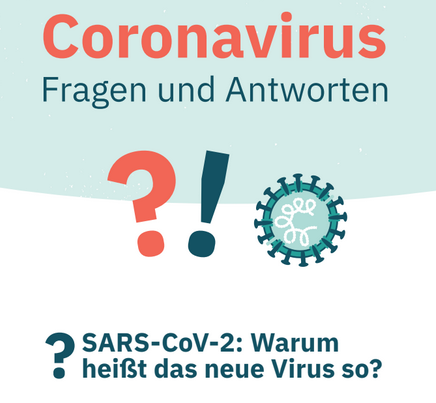
Here is a way of how to use modeling activities with distance-learning. To implement the Educational Pyramid Scheme during the Corona crisis, we developed a ready-to-use teaching package. Have a look by clicking at the following link:
The Innovative Learning Environments Research Group at the Finnish Institute for Educational Research (University of Jyväskylä – https://www.jyu.fi/it/en/research/research-areas/cognitive-science-and-educational-technology/ile) started an intensive collaboration with schools in the “Modeling at School” Erasmus+ project (https://www.jyu.fi/it/en/research/research-areas/cognitive-science-and-educational-technology/ile/projects/mas).
Right before Finnish schools have been closed because of the COVID-19 crisis, representatives of the Finnish Modeling at School team, Tiina Mäkelä and Kristóf Fenyvesi visited University of Jyväskylä’s Teacher Training School and involved teachers and a group of 6th graders in various modeling activities.
Our computer science-based activity diagrams have also helped to memorize the guidelines of the proper hand wash and understand the security protocol of what to do in case if someone suspects having COVID-19 infection.

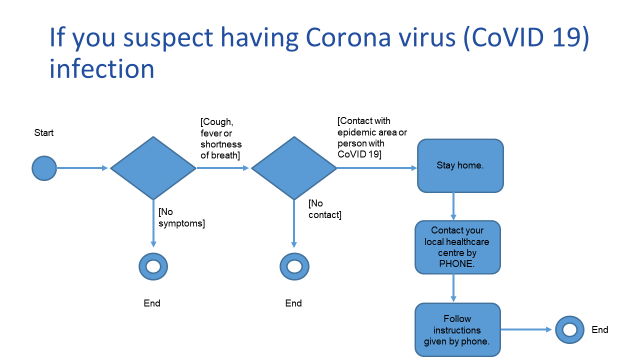
In addition to the practical implementation of diagrams in a crisis situation, the students had time to experience the use of diagrams in subject-based learning as well. At handcraft class, the students decided to support with diagrams their project on product design.
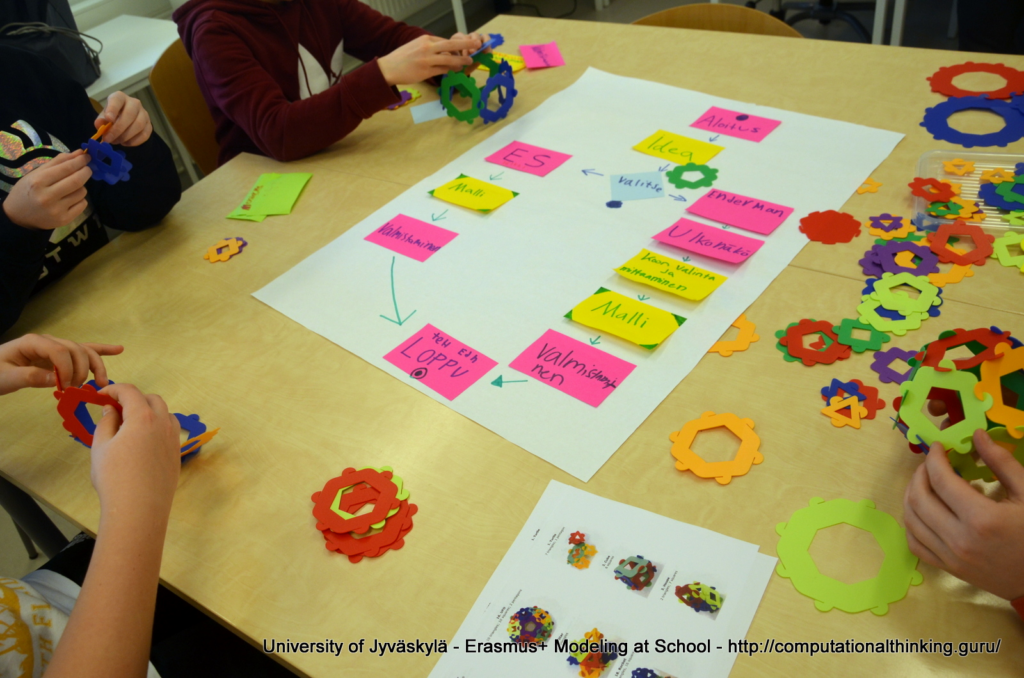
At the end of the class, the students discovered that the process of product design from the starting idea to the manufacturing can be supported greatly by algorithmic thinking.
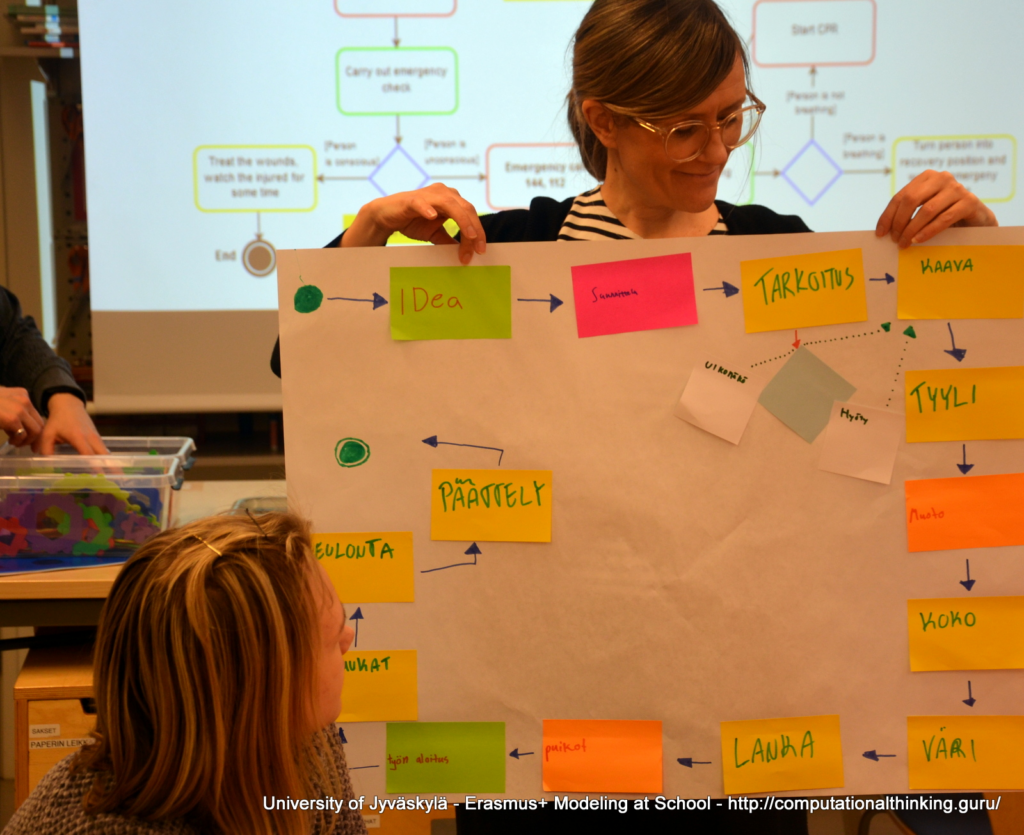
The students were busy and had big fun on working in teams on diagrams of various product designs. They were also excited to see the outcome of their algorithms by constructing the rapid prototypes of their designs by using the ITSPHUN geometric modeling kit.
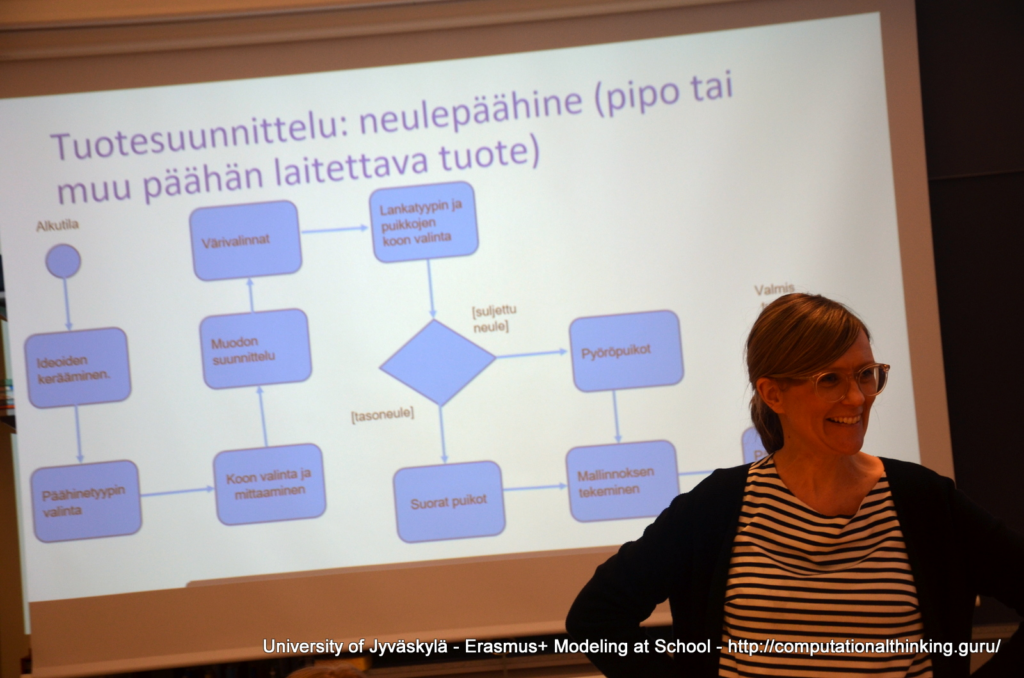
Currently, the Finnish Modeling at School team is preparing distance learning materials to make quarantine learning more enjoyable and motivating with Computational Thinking-related activities.
If you want to know more about the “Modeling at School” Erasmus+ project, please
- check out our project page: https://cool-lab.net/modeling-at-school/
- like us on Facebook https://www.facebook.com/diagram.guru/
- follow us on Instagram https://www.instagram.com/diagram.guru/
- sign up to our Youtube channel: https://www.youtube.com/channel/UCbQmMFKPO7-86w4YAxll4ww
Contacts in Finland:
Finnish Institute for Educational Research
University of Jyväskylä
Kristóf Fenyvesi:
Tiina Mäkelä:
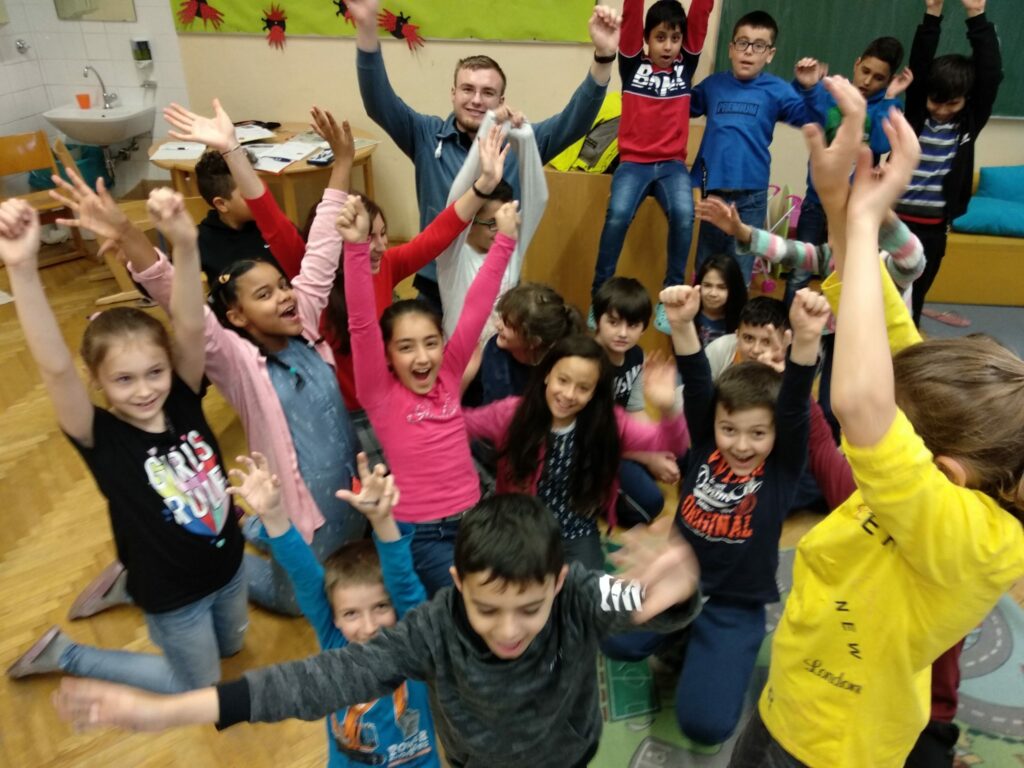
How does a poet manage to visit 12 countries on 4 continents in 3 minutes?
A multicultural primary school project to foster Computational Thinking.
Every year, the Johannes Kepler University organizes the so-called Childrens’ Congress. For this event, pupils from the 1st up to the 8th grade slip into the role of researchers and try to discover computational thinking in everyday life. With support from staff members of the department of STEM education and/or students of the teacher training, they develop their own creative projects within a few months to finally present it at the congress.
In 2019, the Goethe primary school participated at the Children’s Congress for the first time and incorporated two essential IT concepts into their project: modeling & coding.
The 3rd grade of the Goethe primary school in Linz is a very unique group since the 24 pupils come from twelve different countries on four continents. The aim of the project was to embrace this multiculturalism by getting to know more about the students’ cultures. The MaS team introduced modeling to the pupils and together they elaborated some background information on the different countries. In small groups, the students then developed class diagrams with the most important facts and arranged them by continents. The children had great fun modeling and it helped them to visualize the countries main features such as flag, language, inhabitants or size. Thanks to the same structure of the diagrams and their arrangement, the children were able to get an overview of all countries of origin.
At the congress, Johann Wolfgang von Goethe, after whom the school is named, visited the countries of origin of the children. For this purpose, a Goethe-Ozobot traveled the states on a self-drawn map. For Goethe’s visit, the children also programmed Ozobots, who welcomed him with dances in the respective states.

